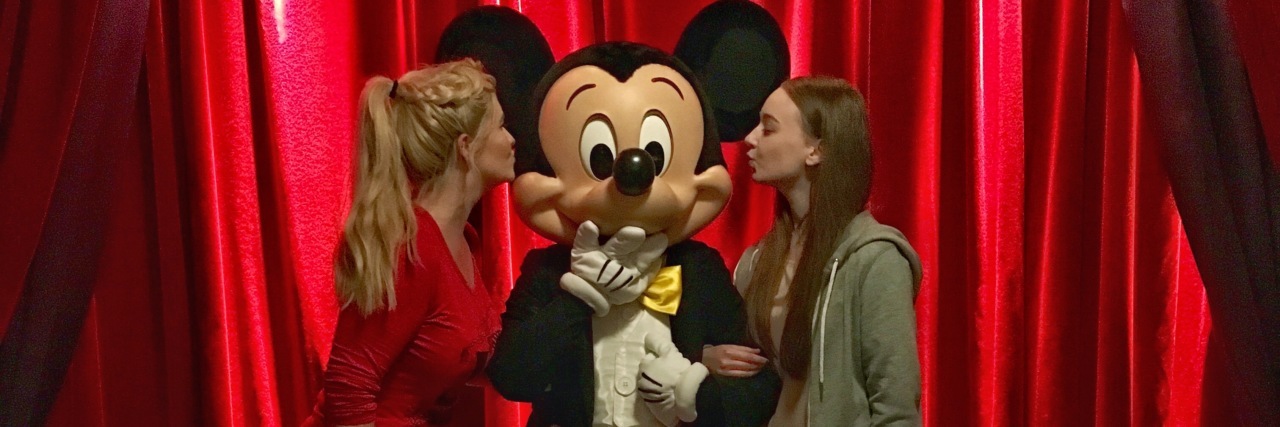This time last year I was visiting Disneyland Paris as a disabled guest for the first time, and today I’m reflecting on what it taught me about public perceptions of invisible illness.
Something I often consider is at what point an invisible illness becomes visible “enough.” Why? Because despite using an extremely visible mobility aid, many non-disabled people are still inclined to question whether I actually look unwell enough to need a wheelchair. I’ve talked many times about people’s perceptions of my invisible condition, and what it’s like to be an invisibly ill wheelchair user, however, it was my recent experience at Disneyland Paris, using their access card system for the first time, that was a particular eye-opener for me.
For those who don’t know, the Green Access Card is a majestic little piece of paper that allows people with specific conditions and impairments to jump to the front of ride queues, skip the lines for meet and greets, and even bag the best viewing spots for all the shows. Essentially, it’s like holding a Golden Ticket to Willy Wonka’s chocolate factory. However, with using such an awesome system came unwanted attention that really highlighted just how stigmatized invisible conditions still continue to be.
In Disneyland, you enter rides from the exit, so that all those poor people who’ve queued relentlessly for hours to get on their favorite rides have to watch you glide past and hop on and off the attraction before they’ve even edged forward an inch. This is where things got slightly uncomfortable. Each time I approached a ride, I knew that all eyes were on me as I calmly stood up from my wheelchair and carefully made my way to my seat on the attraction. Sometimes, the intense attention could simply be attributed to people’s curiosity or sheer boredom from waiting in line. Other times, you could pick up the raised eyebrows from a distance: people wondering what was actually ‘wrong’ with this person who looked and walked exactly like them, and why they were getting this special treatment.
Each time I made this small journey, I couldn’t help but wonder whether there was anything I could do to give this attentive audience just the slightest insight into the numerous hidden symptoms I experience on a daily basis. My friends and I often joke about how people might be more accepting if I dramatically face-planted out of my wheelchair onto the ground and proceeded to let them drag me across the floor from A to B, and whilst that is clearly something I’d never do (for one, I’ve seen what people throw on those floors when they think nobody is looking…), you can’t help but wonder whether people’s perceptions would change at an outright display of suffering. At what point does a condition become visible ‘enough’ to meet the general public’s satisfaction? And why am I questioning how to make my illness more visible, when really I should be questioning why my condition has to be visible to be validated?
To an extent, I can understand. Many of Disneyland Paris’ visitors are British, and if there’s one thing us Brits like, it’s a good orderly queue system. To have waited for such a long time and then had to witness somebody appearing out of nowhere, then seemingly abandoning their mobility aid that got them there in the first place? Before I got ill, who’s to say I wouldn’t have made assumptions too?
However, this is what I’d like them to know. Not only is my illness invisible, so is my condition management. My holiday wasn’t spent waltzing between attractions from dawn until dusk. On a typical Disney day, I had a few hours outdoors, followed by solid bedrest, a heck of a lot of medication and usually extreme coercion from my best friend before I could face venturing outside again. I live with constant chronic pain and fatigue; to have to queue for just one attraction, even in my wheelchair, would leave me suffering for the rest of the day. And if you made me choose between spending my diminishing energy waiting in a queue for a ride, I might be too poorly to do it by the time I reached the front, or pacing myself and making sure I’m well enough for cuddles with Mickey Mouse, I’m sure it’s a no-brainer which one I’m going to choose. You might wish for my magical Access card, but trust me, you can have it if you take my chronic illness too. Maybe I don’t look ill ‘enough’ to satisfy your curiosity or avoid your assumptions, but that doesn’t make my illness experience any less valid.
In the future, I hope that Disney continue to develop their wonderful accessibility practices, that the general public’s awareness and tolerance of chronic invisible conditions continues to increase, and perhaps most importantly, that I get to go on It’s A Small World some time again in the near future. That ride is seriously adorable.
If you’ve had similar experiences to me, I’d be really interested to hear them — you can find me on Twitter and Instagram.
How do you think we can help remove the prejudice surrounding invisible illness?
Image by Pippa Stacey

